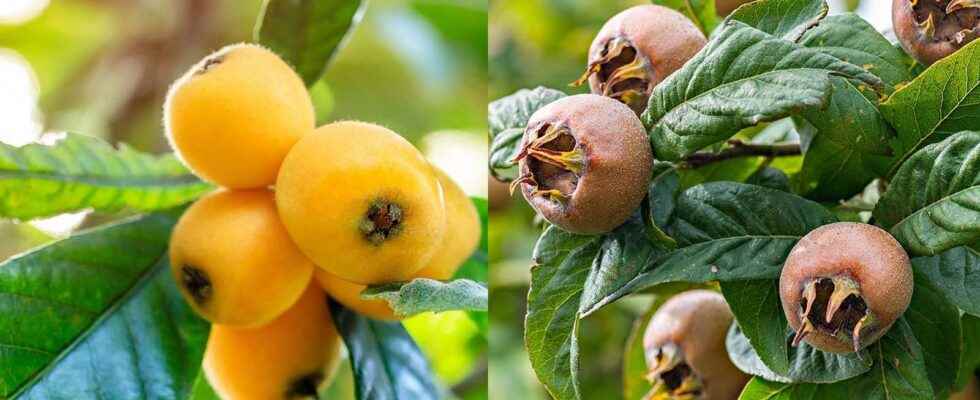This little-known old fruit, of rounded or elongated shape depending on whether it is common medlar or Japanese, has the particularity of offering a sweet and tender flesh. Discover the medlar, this forgotten fruit that will surprise you!
Medlar season
The common medlar (Mespilus germanica), also called from Germany, grows on a tree with foliage lapsed which belongs to the Rosaceae family (Rosaceae) and which develops small flowers in spring. It produces a multitude of round, brown-skinned fruits with five sepals pointed which each produce five seeds. The fruits have the skin of color brown and eaten in the first frosts, once overripe and soft, between October and November. The fruits are eaten completely ripe to find a sweet flesh, with a slight apple-pear taste.
The Japanese loquat (Eriobotrya japonica), from the same family, is an evergreen tree that produces elongated fruits containing one or more stones (which cannot be eaten), between April and June. Its flowering takes place in fall with very fragrant flowers reminiscent of almonds and appreciated by insects pollinators. Each yellow-skinned fruit contains a stone and its yellow-orange flesh remains tender.
Nutritional qualities of medlar
This small fruit is rich in minerals, vitamins A, calcium and potassium.
Medlar varieties
The Japanese medlar is cultivated in the south of France while the common medlar prefers northern Europe:
- Japanese medlar ‘Tanaka’: hardy variety with large fruits with juicy and firm flesh;
- Japanese medlar ‘Golden Nugget’: rounded in shape, the dark orange fruit has a tangy orange pulp;
- Japanese medlar ‘Teddy’: large fruits of pale yellow color with a very fleshy and sweet flesh;
- Japanese medlar ‘Rose Anne’: medium-sized fruits with yellow-orange skin.
- medlar ‘Nottingham’: medium-sized fruits with sweet flesh;
- medlar ‘Westerveld’: fruits about three centimeters in diameter with a very sweet and creamy pulp;
- medlar ‘Délice de Vannes’: medium-sized, very fragrant fruits.
Preserve the medlars
Medlars are best eaten after harvest. Picked in October, the common medlars must be fully ripe and stored in a cool, dark room, on a bed of straw placed in crates in drink broken down for a month so that the fruits are edible.
Fragile to handling, cook medlars quickly in jellies, compotes or jams. Try the experience of a medlar fruit paste or a compote. Also prepare them in jelly to accompany a poultry. Once pitted, place them on a pie or incorporate them into a clafoutis.
You will also be interested
Interested in what you just read?
.
fs12
